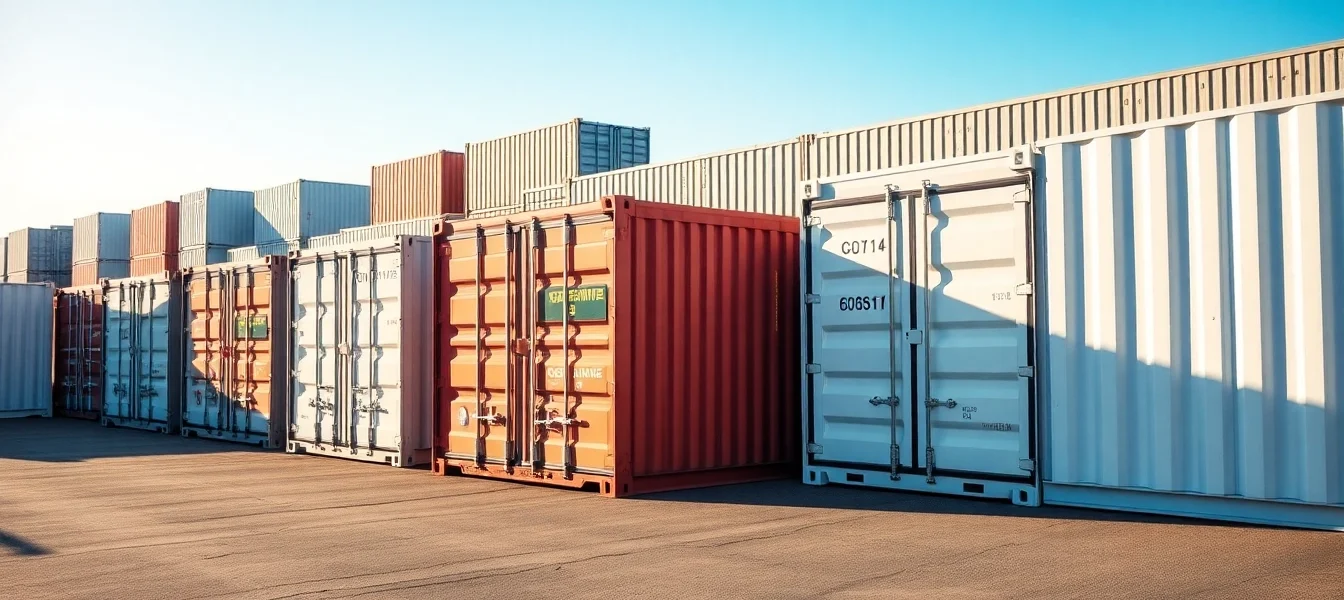Streamlined Container Rental Solutions to Boost Your Business Efficiency in the UK
Understanding Container Rental: Types and Uses
Container rental has become an integral solution across a multitude of industries and applications in the UK. Whether for storage, transportation, or temporary structural needs, renting containers offers flexibility, cost efficiency, and scalability that traditional solutions often cannot match. As demand continues to grow, it’s crucial for businesses and individuals to understand the different types of containers available, their primary uses, and what factors influence their suitability for specific projects.
For those exploring container rental options, a great starting point is understanding the variety of sizes and configurations available. A comprehensive approach involves assessing the specific needs of your project, reviewing operational constraints, and knowing what types of containers best fit your purpose. This guide aims to provide an in-depth overview, helping you make informed decisions that optimize your investment while ensuring operational efficiency.
Popular Container Sizes Available for Rental in the UK
One of the most common inquiries regarding container rental pertains to size options. The UK market offers a broad spectrum of container dimensions, with 20ft and 40ft standards being the most prevalent. These sizes are versatile and serve a range of applications, from storage to logistics.
- 20ft Containers: The 20ft container is perhaps the most popular rental option. Its compact size makes it ideal for urban environments with limited space, and it provides approximately 1,170 cubic feet of internal capacity. It’s often used for storing equipment, tools, or inventory for small to medium-sized enterprises.
- 40ft Containers: Larger than the 20ft variant, 40ft containers offer approximately 2,390 cubic feet of space. They are suited for bulky goods, large equipment, or bulk storage. Many logistics companies use 40ft containers for international shipping, which also makes them suitable for rental projects requiring significant volume.
- Other Sizes: Sizes vary from compact 10ft containers to specialized units like 45ft or high-cube containers. These are employed in niche applications such as mobile offices, specialized storage, or construction site needs.
In addition to standard sizes, the UK market also offers bespoke options, including refrigerated units, tunnel containers, and open-top containers. These are tailored to specific logistical or structural requirements, expanding the versatility of rental options available.
Diverse Applications: Storage, Transportation, and Temporary Structures
The scope of container rental extends far beyond simple storage. With modern modifications and customizations, containers serve multiple roles across various sectors:
- Storage Solutions: Businesses often use rented containers for warehousing raw materials, finished goods, or equipment on-site. Temporary storage is particularly vital during peak seasons, office relocations, or construction projects, where onsite space is limited or unavailable.
- Transport and Logistics: Shipping containers facilitate the seamless movement of goods through multimodal transport networks. Renting containers ensures flexible logistics, enabling companies to handle fluctuating inventory without investing in costly permanent infrastructure.
- Temporary Structures and Site Accommodation: Containers are increasingly adapted into offices, site sheds, restrooms, or even pop-up retail units. Their modular nature allows easy customization to suit operational or customer-facing needs in diverse environments.
For example, construction firms often rent high-security, durable containers to store valuable tools near active sites, ensuring security and weather protection. Event organizers may rent large containers to serve as ticket booths, storage for equipment, or temporary facilities, integrating functionality with ease of deployment. The capability to modify containers—adding insulation, electrical wiring, shelving, or signage—further broadens their application spectrum.
Differences Between New and Used Containers for Hire
When selecting a container for rental, a key consideration is whether to opt for a new or used unit. Both options provide distinct advantages and considerations, impacting cost, durability, and appearance.
- New Containers: Brand new containers are freshly manufactured units, often offering the latest in structural integrity, paint, and corrosion resistance. They usually come with warranties and are less likely to have pre-existing damage. For projects requiring maximum security, aesthetic appeal, or compliance with specific standards (such as food storage or sensitive equipment), new containers are the best choice. Their higher initial cost is offset by longevity and peace of mind.
- Used Containers: Used containers are pre-owned units, often sourced from decommissioned shipping lines or previous rental fleets. They are generally more affordable—sometimes significantly so—and suitable for temporary or less sensitive applications. With proper inspection and maintenance, used containers can still offer robust durability, making them an economical choice for short-term projects or where appearance is less critical.
Suppliers typically grade used containers into categories based on condition, with ‘Grade A’ units appearing nearly new and ‘Grade C’ units showing more wear. It’s vital to verify the condition, structural integrity, and any potential corrosion or damage before renting used containers. Many providers also offer refurbishment services, ensuring used units meet safety and operational standards.
Ultimately, the choice hinges on your budget, project duration, and quality requirements. Consulting with a reputable rental provider can help you balance these factors to maximize value and operational suitability.
How to Choose the Right Container Rental Provider
Assessing Rental Terms, Costs, and Delivery Options
Choosing the right provider begins with evaluating the rental terms offered. Critical considerations include rental duration flexibility, costs, and delivery or collection services. Flexible terms—such as short-term rentals of a few weeks or long-term agreements spanning months or years—are essential depending on your project timeline.
Pricing transparency is equally important. While base rental rates can seem straightforward, additional charges—such as delivery, pickup, and maintenance—can significantly influence the overall cost. Reliable providers clearly outline these fees upfront, helping you avoid unexpected expenses.
Delivery and collection logistics must also be assessed. A provider with extensive delivery coverage across the UK ensures timely placement and removal of containers, critical for project scheduling. Confirm whether transportation costs are included or charged separately, and inquire about alternative options like portable containers that can be relocated easily.
Importance of Secure and Compliant Containers
Security and regulatory compliance are paramount when selecting a rental container. Containers should be equipped with sturdy locks, anti-theft features, and security enhancements such as alarms or CCTV options if necessary. Ensuring the container complies with safety standards prevents potential legal issues and safeguards your assets.
Additionally, depending on your contents, compliance with environmental and safety regulations is essential. For example, if you plan to store hazardous materials, the container must meet specific standards, including PPE requirements for handling and ventilation systems. Reputable rental providers can advise on compliance and provide containers aligned with legal standards.
Evaluating Customer Reviews and Company Reputation
Before finalizing a rental, conducting thorough research into the provider’s reputation can save you headaches. Reading customer reviews, testimonials, and case studies offers insight into their service reliability, responsiveness, and container quality. Leading providers often have positive ratings across review platforms, indicating consistent customer satisfaction.
Requesting references or viewing case examples of similar projects can help you assess their experience and trustworthiness. Additionally, evaluating the provider’s customer service responsiveness ensures support throughout your rental period, from delivery to maintenance or issue resolution.
Cost Factors and Budgeting for Container Rental
Typical Pricing Models and Rental Durations
Understanding rental costs is vital for effective budgeting. Most providers offer flexible pricing models, such as weekly, monthly, or long-term rates. Short-term rentals, typically under three months, might have higher weekly rates, while longer agreements benefit from discounted monthly or quarterly pricing.
Standard rental costs in the UK range from approximately £50 to £150 per month for a 20ft container, with 40ft containers demanding proportionally higher rates. Some providers also offer all-inclusive packages covering delivery, collection, and insurance, which facilitate straightforward budgeting.
Additional Charges: Delivery, Collection, and Insurance
Additional costs often include delivery and collection fees, which depend on the distance from the provider’s depot to your site, accessibility, and container size. Delivery charges can vary significantly—anywhere from £50 to £300. Some providers include delivery in the rental rate for standard locations, while others charge separately.
Insurance is another consideration. To protect against theft, vandalism, or accidental damage, many rental agreements recommend or require insurance coverage. Costs for insurance can range from £10 to £30 per month, depending on the coverage extent.
Assess all these potential costs beforehand, ensuring your budget accounts for the entire rental cycle, not just the base rate.
Tips for Negotiating the Best Rental Deals in the UK
Negotiation can significantly reduce costs, especially for long-term projects. Here are some tips:
- Bundle services—combine delivery, collection, and insurance into a packaged deal for discounts.
- Leverage competitive quotes—obtain multiple offers to negotiate better pricing or terms.
- Flexibility on delivery dates or container size can be negotiated for better rates.
- Request volume discounts if renting multiple containers or over an extended period.
- Discuss maintenance and repair responsibilities upfront—clarifying these can prevent unexpected expenses.
Best Practices for Container Rental Installation and Maintenance
Proper Site Preparation and Container Positioning
Efficient container installation begins with thorough site preparation. The ground must be level, firm, and free from debris or obstacles to ensure stability and ease of placement. Using a flat, reinforced surface—such as concrete or compacted gravel—reduces settling or shifting risks.
Access pathways should accommodate delivery vehicles, with sufficient clearance for maneuvering. Marking designated areas helps with proper positioning, especially in tight spaces or urban environments. Secure anchoring or blocking may be necessary to prevent wind movement or accidental displacement.
Regular Inspections and Cleaning Protocols
Maintaining container condition extends beyond initial installation. Routine inspections should focus on structural integrity, rust or corrosion, lock functionality, and door seals. Establishing a maintenance schedule—monthly or quarterly—prevents deterioration and prolongs useful life.
Cleaning is equally crucial. Regularly removing dirt, debris, or graffiti preserves appearance and hygiene. For food-grade or sensitive material storage, sanitation procedures meet regulatory standards and prevent contamination.
Maximizing Container Longevity Through Maintenance
Preventative maintenance enhances durability. Applying rust-inhibiting paints and sealants protects against environmental factors. Weatherproofing, such as adding insulation or ventilation systems, reduces condensation and corrosion issues.
Addressing minor damages promptly—such as welding cracks or fixing locks—avoids escalation into costly repairs. Partnering with a reliable container service provider can ensure timely maintenance and support, reducing downtime and operational disruptions.
Maximizing Container Rental ROI for Your Business
Strategic Planning for Short-Term and Long-Term Needs
Effective utilization of rented containers hinges on strategic planning. Short-term projects—like seasonal sales events or construction phases—benefit from flexible, on-demand rentals. Long-term needs—such as ongoing storage or permanent site offices—might justify investing in custom modifications or long-term leasing agreements.
Forecasting your needs involves analyzing inventory cycles, project timelines, and logistics workflows. This foresight allows you to optimize container size, quantity, and rental duration, preventing over- or under-utilization.
Integrating Container Rental Into Your Supply Chain
Container rental can streamline your supply chain by providing just-in-time storage and transportation hubs. Renting modular units allows rapid deployment at strategic locations, reducing lead times and warehousing costs. When integrated effectively, containers enable seamless inventory management and flexible distribution networks.
Implementing integrated tracking systems—such as container RFID tags or GPS—further enhances operational visibility. This real-time insight helps measure utilization, identify bottlenecks, and optimize deployment strategies.
Tracking and Measuring Container Utilization Efficiency
To maximize ROI, ongoing monitoring of container use is essential. Key performance indicators include occupancy rates, turnover frequency, and maintenance costs. Utilizing digital platforms or management software can aggregate data, providing actionable insights.
Regular reviews help identify underperforming assets or opportunities for consolidation. Adjusting allocations based on data-driven analysis sustains operational efficiency, reduces unnecessary expenses, and enhances overall cost-effectiveness.


